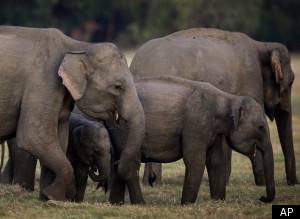
By BHARATHA MALLAWARACHI
Thousands of rangers and volunteers have climbed into treetop huts near reservoirs and watering holes in Sri Lanka to carry out the island nation's first full count of its dwindling wild elephant population.
The government says the three-d ay census through Saturday is aimed at devising a plan to protect the elephants. But several conservation groups have boycotted the count, accusing the government of using it as a "smoke screen" for capturing and domesticating the best young animals for use in temples, tourism and labor.
Sri Lanka closed all its national parks to tourists for the census starting Thursday and sent nearly 4,000 wildlife workers, farmers and villagers to more than 1,500 locations across the country to survey the elephants as they come to water sources for a drink.
"I've been in similar huts while staking out poachers, but this is a different experience, watching elephants under the moonlight," said Damith Bandara, a ranger who spent the night with two other volunteers six yards (meters) up a tree near the Minneriya reservoir in central Sri Lanka.
Officials believe Sri Lanka's elephant population is currently 5,000 to 6,000.
In the early 1900s, an estimated 10,000 to 15,000 elephants roamed wild on this tropical island off the southern coast of India. But poaching and the loss of habitat due to human activities such as deforestation for farming have taken their toll.
Wild elephants are increasingly entering villages in search of food, rampaging through houses, destroying crops and killing an estimated 50 people a year.
Around 250 elephants are killed annually, mostly by farmers defending their crops or villages.
Officials say the census will give a rough estimate of the country's endangered elephants as well as other information that can help reduce conflicts between them and people.
"Our objective is not to get an exact number of elephants," said Sarath Dissanayake, the director or training and research at the Wildlife Department. "Our main objective is to understand the population structure of the elephants, that is proportion of calves, adults and sub-adults, juvenile, male and female."
The survey will give officials an idea of where the elephants roam, what food is available to them in the area and the likelihood of them invading villages and farms, he said.
At the 9,000-hectare (22,000-acre) Minneriya National Park, ranger Bandara and his two companions were camped out in their treetop hut with a three-day provision of food, medicine, a flashlight and manuals about how to do the elephant count. They were at one of a dozen posts in the park.
Thursday night, they observed three herds of up to 30 elephants, including a large male with only one tusk, drinking from the reservoir.
They catalogued the elephants by age, gender and distinguishing characteristics to ensure there is no double counting.
Raman Sukumar, an ecologist from India helping in the census, said the herds had many young elephants, indicating they were "very fertile."
About 20 wildlife groups that had agreed to deploy about 200 volunteers for the count withdrew their support after Wildlife Minister S.M. Chandransena was quoted as saying 300 young elephants would be captured and handed over to Buddhist temples after the census.
Elephants in elaborate costumes are often used in Buddhist ceremonies where they parade through the streets carrying the sacred relics of the Buddha.
Chandransena later said he was misquoted, and the head of the Wildlife Department, H.D. Ratnayake, denied that the government planned to capture any wild elephants.
However, Rukshan Jayawardene, chairman of the activist group Wildlife Conservation Forum said he feared that animals were slated for capture and that they would not end up in temples, but "in private residences, working long hours."
Some wealthy, aristocratic families consider owning an elephant a sign of prestige. Domesticated elephants also are used to give rides to tourists and to carry heavy weights, such as in the logging industry.
Most tamed elephants die early due to lack of proper food and lives of hard labor, said Shantha Jayaweera, another wildlife activist.
Previous elephant counts were confined to specific regions. One such census in 1993, found 1,967 elephants, but it excluded the island's north and east, where a civil war was raging at the time. With the war's end in 2009, wildlife officials now have access to the former war zones, and are conducting the survey with the help of armed forces.
The results of the count are expected by the end of the month.
Article courtesy of huffingtonpost.com

